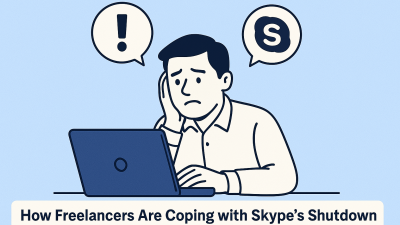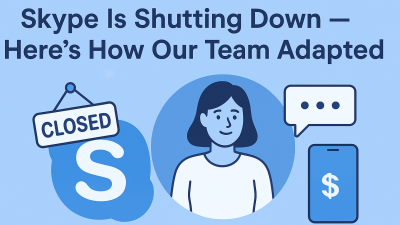When Microsoft announced that Skype would shut down in May 2025, most tech media ran the same angle: it’s the end of an era. But that headline doesn’t capture what it means for the people who relied on Skype not for nostalgia, but for business.
For countless small business owners, Skype was more than video calls. It was how deals were closed, client updates were delivered, partners overseas were brought into the loop, and support calls were handled without a second thought.
It worked across devices. It wasn’t tied to a sales platform or calendar system. And more importantly, it kept costs down for businesses that couldn’t afford bloated tools or clunky software.
So now that it’s disappearing, small business owners aren’t just moving on — they’re being forced to reassess the very systems they’ve built over years. And most don’t want more features. They want something that works the way Skype did, just without the uncertainty.
The Official Line: Microsoft Wants Everyone on Teams
Microsoft says Teams is the future. And in many ways, for larger organizations, it might be. It connects with Microsoft 365. It manages internal workflows. It can run meetings, host live events, and manage files in real time. That’s great — if you’re a large company.
But for independent professionals, two-person agencies, or family-run businesses with clients overseas, the pitch doesn’t land the same way.
Teams wasn’t built for fast, lightweight communication. It’s structured. It has rules. And it assumes you’re working inside an organization that shares documents, hosts meetings, and collaborates all day.
Most small businesses don’t need that. They need something faster. Something simpler. Something that doesn’t take a full week of onboarding to just make a call.
That’s why this isn’t just a shift in software. It’s a shift in control — from a flexible tool that served a broad range of use cases, to a system that assumes you’re part of a bigger machine.
Business Owners Aren’t Just Reacting — They’re Re-Evaluating
When a communication tool disappears, you don’t just swap apps. You rethink how you handle every part of your client-facing workflow.
One owner of a packaging export business shared how Skype allowed them to call multiple suppliers across Southeast Asia without worrying about cost. Another consultant used it daily for client check-ins across four time zones. These aren’t edge cases — they’re the backbone of how small, nimble businesses operate globally.
Now, those workflows are being rebuilt from the ground up. Not everyone is following Microsoft’s recommendation. Some are moving to WhatsApp. Some to Zoom. Others are stepping away from all-in-one solutions entirely and asking a more focused question:
What’s the simplest, most reliable way to keep calling clients, partners, and suppliers around the world — without adding complexity, hidden costs, or IT headaches?
That’s where MyTello enters the conversation.
Why MyTello Is Quietly Becoming the Go-To Replacement

MyTello isn’t trying to be the next big platform. It’s not competing with Microsoft on features, integrations, or enterprise dashboards. It’s not promising to replace calendars or become your new virtual office. And that’s exactly why small business owners are paying attention.
Here’s what MyTello does: it makes international calls easy, affordable, and completely app-free. You don’t need to send someone a meeting link. You don’t need to install anything. You just dial, connect, and speak — exactly the way business conversations are supposed to work.
It’s built around a core truth that a lot of bigger platforms seem to forget: most communication isn’t collaboration — it’s conversation. Direct. Clear. Actionable.
When small business owners compare MyTello to Teams, the difference is immediate. Teams might offer more “tools,” but MyTello wins where it counts: speed, reliability, and simplicity. You don’t log in to launch a dashboard. You don’t wait for calendar syncing. You don’t invite a contact and hope they’ve joined the same ecosystem. You just call.
And for businesses that rely on that rhythm, that need to make ten calls in ten minutes, or reach someone who’s not checking email — that difference isn’t small. It’s everything.
The Real Cost of Switching Isn’t Just Technical — It’s Operational
The biggest misconception in this transition is that moving away from Skype is a simple platform choice. It’s not. It’s operational.
When you run a small business, every tool you use becomes part of your process. Changing that means changing how you work. You need to retrain your staff. Rebuild client habits. Rewrite how meetings are scheduled, how support is delivered, how sales follow-ups happen. That ripple effect touches everything.
And when the tool you’re switching to requires more time, more setup, and more navigation, you’re not just adjusting. You’re paying twice: once in cost, and once in attention.
That’s why owners are resisting complexity. They’re not trying to be anti-change. They’re protecting focus. Because in a small business, focus is leverage.
When Simplicity Becomes a Business Advantage
The truth is, most small business owners don’t care about platform loyalty. They care about what works. When Skype shuts down, the priority isn’t “what app looks like Skype” — it’s “what lets me keep doing business without interruptions.”
That’s why tools that stay out of the way are getting attention. MyTello isn’t built around project management or team collaboration. It’s built around something more essential: connection.
You make a call. You talk to your supplier in real time. You check in with your contractor overseas. You get a verbal agreement confirmed in minutes. That’s not a feature. That’s business continuity.
The small businesses adapting fastest aren’t the ones chasing the next platform. They’re the ones finding the cleanest way to replace a critical tool, without complicating everything else around it.
Why MyTello Fills the Gap Skype Leaves Behind
Skype earned its place in small business workflows because it did one thing better than anyone else for a long time: international voice and video calls, without friction. Not tied to SIM cards. Not dependent on apps both people had to install. Just you, the number, and the connection.
MyTello doesn’t try to reinvent that experience — it honors it. But it does it with better call quality, simpler billing, and no reliance on clunky desktop apps or outdated interfaces.
Here’s how it plays out in the real world:
-
You call a vendor in Germany from your mobile, and the quality is crystal clear.
-
You call a client in South Africa, and you’re not worried about signal drops or syncing.
-
You top up credit once and get a breakdown of costs without digging through menus.
You’re not managing teams. You’re managing relationships. And that’s exactly where MyTello fits — one conversation at a time.
What Business Owners Are Actually Saying
It’s not just marketing. Owners are talking about this shift in forums, chats, and comment threads — and the tone is consistent.
“Teams is fine, but we don’t need to ‘collaborate.’ We just need to call people in four countries a week without issues.”
“Skype was a staple. We didn’t realize how much we relied on it until we had to move. MyTello made that transition way easier than I expected.”
“I don’t want my admin team learning a whole new platform just to call our logistics partner. They logged into MyTello, added credit, and called. That’s all we needed.”
These aren’t feature reviews. They’re operational verdicts. And they speak to the real pressure small business owners face: every tool has to earn its place. Not with buzzwords — with utility.
What to Consider Before You Choose a Replacement
If you’re still figuring out your post-Skype setup, ignore the hype and focus on three questions:
1. Who do you need to talk to, and how often?
If your business involves frequent international calling, prioritize tools built around call clarity, not just messaging or meetings.
2. Do your contacts need to use the same platform?
If your client or vendor has to download something or set up an account before you can talk to them, you’ve already added friction. That costs you time — and possibly trust.
3. Can your team use it without training?
Most small businesses can’t afford a week of onboarding. The best tools are the ones your team can figure out in ten minutes, without calling IT or reading tutorials.
MyTello checks all three boxes. That’s not a claim — it’s a reason many businesses are quietly making the switch without waiting for a blog post to tell them to.
A Transition Path That Doesn’t Disrupt Your Workflow

You don’t need to reinvent your entire communication system. You just need a tool that lets you do what you were already doing — calling, checking in, moving business forward — with as little disruption as possible.
Here’s what that could look like:
-
Keep your contact list from Skype. If you exported it, great. If not, jot down the numbers that matter most.
-
Open a MyTello account. It takes minutes, not hours.
-
Make a test call to your most frequent international contact. Listen to the quality. Time the connection speed.
-
If it works? You’re done. There’s no follow-up course, no need to “learn” anything.
This isn’t a system reboot. It’s a continuity plan.
Small Doesn’t Mean Less — It Means You Can Move Faster
One of the strengths of small businesses is agility. You don’t need layers of approvals to switch tools. You don’t need to wait on IT to test something new. You can shift today, and be calling clients again this afternoon — on your terms.
Big platforms are built for big systems. But most business is done in simple, direct, repeatable moments. Conversations. Confirmations. Relationship maintenance.
The best tools honor that scale. They don’t assume you’re trying to scale to 500 employees. They assume you’re trying to get paid, deliver on time, and keep your customers coming back.
That’s why MyTello isn’t a replacement for Teams. It’s a replacement for everything Teams adds when all you really needed was a call.
Final Thoughts: Replace the Outcome, Not Just the App
Skype’s going away. That’s out of your control. What you do next — that’s yours to own.
Don’t look for a platform that matches Skype screen-for-screen. Look for one that gives you the same results — connection, clarity, speed, affordability — without locking you into something bigger than you asked for.
If calls are a part of how you do business, make sure your next tool respects that.
The switch doesn’t have to be loud. It doesn’t need an onboarding manual or a brand workshop. It just needs to work — consistently, clearly, and without wasting your time.
That’s the difference between a platform and a partner. That’s the reason more small businesses are choosing MyTello.



